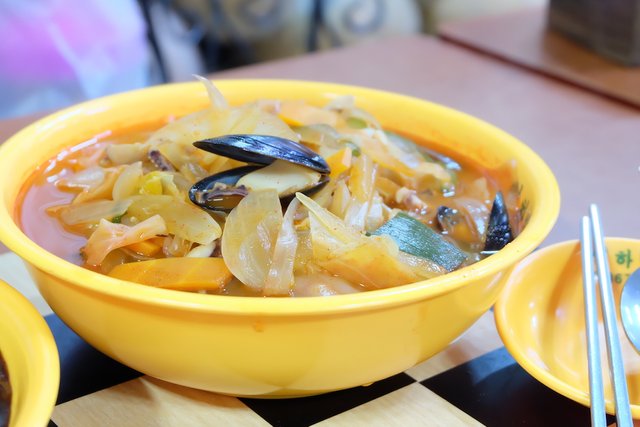
Every country and region has its own “comfort food” and one of the most popular in Korea is jjamppong. Many people believe that jjamppong originated in China but had a very different name. During the Japanese occupation, the Japanese started calling it “champon.”
What is Jjamppong 짬뽕?
It is a blend of seafood, meat(s) of your choice, vegetables and noodles. You can find jjamppong all year round but it’s most common during the winter months. Unlike many comfort foods from around the world, jjamppong is relatively healthy as it contains a balance of vegetables, seafood protein, loaded with capsicum and is usually moderate in calories. Many studies have shown capsicum to be excellent for the circulatory system, blood pressure and cholesterol. Jjamppong is usually eaten with noodles however, you can always substitute those with rice to make jjampong bap.
Jjamppong in TV and Music.

Rainbow's Kim Jae-kyung eating jjamppong on variety show
As a favoured dish across Korea, it was featured as a challenge on a show to benefit the victims of the tsunami, “Surprising Competition Star King (노라운 대회 스타킹)” . On it Kim Jae-kyung, from Rainbow, was happy to be a guest. Another variety show, MBC Korea’s “Very Private TV (아주 사적인 TV),” asked stars to share their favourite foods with the viewers. Yeongji of KARA shared her love for jjamppong and proved it when she returned to eat every last bite, after the camera stopped rolling!
Why this recipe?
We picked this version of the recipe for its simplicity. It is quick and easy to make most of all, it needs very little prep time. Share pictures of your jjamppong – we hope you eat well!
Jjamppong 짬뽕
Ingredients:
1 package Chinese egg noodles (long) or udon noodles
1/3 cup pork, thinly sliced
6 medium shrimp, peeled and deveined
½ cup squid, cleaned and thinly sliced
6 clams or mussels, scrubbed clean
4 dried shiitake mushrooms (black forest mushrooms), re-hydrated and thinly sliced
1 small onion, halved and sliced
½ medium carrot, julienned
1 scallion, cut into 2-inch pieces
1 cup Napa cabbage, sliced into 1-inch chunks (can also substitute with bok choy or thinly sliced American cabbage)
1 green chilli pepper, seeded and sliced
1 red chilli pepper, seeded and sliced
2 tsp minced garlic
1 tsp minced ginger
7 cups chicken, beef, or anchovy broth
2 tbsp soy sauce
1 package fresh udon noodles
1 tbsp kochukaru (Korean red chilli pepper flakes)
Salt and pepper to taste
1 tsp fish sauce (optional)
Method:
In a large pot, cook the egg noodles (or udon noodles) according to package directions. Make sure not to overcook noodles, check them often to make sure that are exactly the way you like them. Remember that they will soften a little more when you add the soup to them. Drain and set aside.
In a soup pot, bring mussels (or clams) and 2 cups of water to a boil. Cover, reduce heat to low simmer, and cook for a few minutes until shells open. Drain and reserve mussels or clams for later.
Add one cup of cooking liquid to the chicken broth (or beef or anchovy versions). Heat a well-oiled deep sauté pan or large wok and sauté garlic and ginger briefly (careful, these can burn quickly).
Add chilli pepper flakes (kochukaru), pork, and onions. Stir-fry.
After a few minutes, gradually add shrimp, squid, carrots, scallions and stir fry, followed by the cooked mussels (or clams), cabbage, and broth.
Bring mixture to a boil, then reduce heat to a medium simmer and let cook for about 5 more minutes. Add soy sauce and salt and pepper to suit your personal taste.
Place noodles in individual soup bowls and generously cover noodles with the soup.